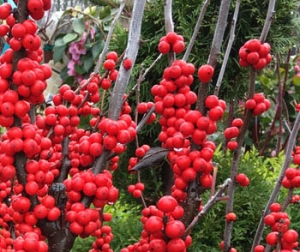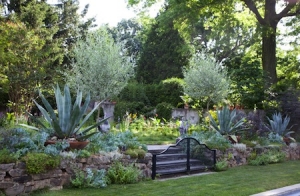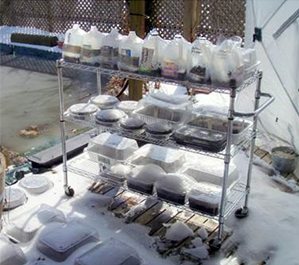A Resolute Gardener Resolves Again
By Jo Anna Natale, Fairfax Master Gardener
While the rest of the world is making New Year’s resolutions that involve eating less and planking more, we gardeners are creating our own goals, and our goals involve dirt.
This year, I’m going public with mine for two reasons. First, by writing down my gardening goals and sharing them, I’m more likely to pursue them, right? And second, others might see in my list something to which they also might aspire. So here goes. In 2018, this gardener resolves to:

Ilex verticillata berries
Winterberries, also known as deciduous hollies, have so much to give in winter, when the landscape exhibits the full range of brown, and the birds have so little to eat. (See Plant Some Winterberries Already!.) Their berries, colored brilliant red or coral, energize a mopey backyard like a venti-sized espresso. Birds benefit, too, finding sustenance there when their usual buffet thins. With winterberries, though, the key is to plant at least two — a female and the male necessary for pollination (and berries). I’ll make it a threesome, though, because good garden design loves threes.
Go to Chanticleer — again
Chanticleer is a botanical garden just outside Philadelphia that I cannot get out of my mind. I’ve been there twice so far, both times in spring, and I have never seen such a creative, soul-enlivening green space. Its gardeners and designers are experts at combining plants in lovely and surprising ways. (Think poinsettias paired with pansies and landscapes celebrating decay.) My goal is to visit sometime other than spring so I can see how this inspirational gem shines in other seasons, too.

Chanticleer
Build some raised beds
The soil in my vegetable garden, going on a dozen years improved, is compost heaps better than it used to be but still falls short of producing the potager of my dreams. Raised beds, I’m convinced, would bring me closer to a robust and abundant garden of vegetables and herbs. With raised beds, I could instantly create better conditions by filling my beds with soil that is rich in nutrients and free of the weed seeds and clay encumbering my current garden soil.
Learn more botanical names
Knowledge of plant botanical names — and yes, they are in Latin — separates the expert gardener from the novice, and my aim is to become as expert as possible. Once you have botanical names down, you can talk about plants with greater specificity, and you can understand some of the plant’s characteristics or origins. Pinus virginiana? Prunus pendular? The Latin name reveals a lot about a plant; Latin is the language of gardening, and it is time to embrace more of it.
 Try cold-weather sowing
Try cold-weather sowing
What an intriguing idea: Sow seeds in containers plucked from the recycling bin, stick them outside in the snow and cold, and grow outdoors in mid-winter seedlings that will be ready for the garden in spring. (See Sow Your Seeds Outdoors — in Winter!.) Not only will this technique fend off winter boredom, it will save me money on the electricity I’d use to run grow lights in my basement and on the nursery plants I’d typically buy in April and May. Counterintuitive and frugal. I like it.
Edit my garden
Just as writing improves when shorn of its excesses, garden beds improve with periodic editing. This has been a hard lesson for me, as I prefer gardens that run a little wild — cottage over formal, spontaneous over sculpted. But forgo dividing and pruning plants, and trouble ensues. Crowded conditions invite mildew and fungi to party on plants that lack good air circulation. Pruners and spades, I must remember, are my friends.
Double up on bird feeding in February
For birds, February can be the cruelest month. Long gone are the seeds and berries that were readily available on flower heads, shrubs and trees in November. In February, birds need more food sources in the form of birdseed and suet, or they might not live to herald spring and reproduce. That’s a loss I do not want to risk.
Weed a little each day
Weeding is about as pesky as bed head (and as easily tamed) when I attend to it each day. But let it go for several weeks, and I end up battling a Medusa’s snarl of snakes. Best to resolve to work smart in my garden and weed for 20 minutes each morning.
Plant basil earlier; make pesto sooner
Like it or not (and who could like it?), basil downy mildew has found its way to Northern Virginia. For pesto lovers like me who plant Genovese basil with abandon, basil downy mildew is brutal. It marks, then kills, basil plants just when their leaves are most luscious. If pesto is my goal, I need to harvest my basil before it reaches its prime. That’s a shame, but it’s a fact. (See Basil Downy Mildew.)
Share more; plants are part of my legacy
When my beds were new, I had a policy: Refuse no free plants. This is how I built the base of my gardens, from the generosity of other gardeners who divided their darlings. I think of these people every time I enjoy the blooms and foliage that originated with them. Now it’s my turn. My gardens are full, but my beds grow verbose. In sharing plants, I help other gardeners shape their visions. Plus, a little part of me gets to take root in their lives. Pretty cool.
That’s it. Ten gardening resolutions. They may seem simple, but they would add so much to my garden — and my gardener’s sense of satisfaction — should I accomplish them in 12 months.